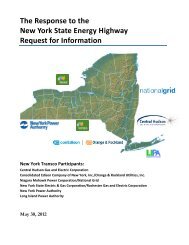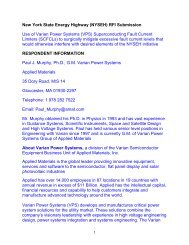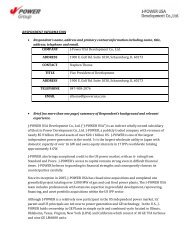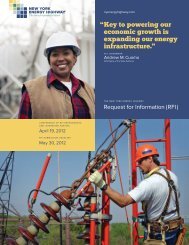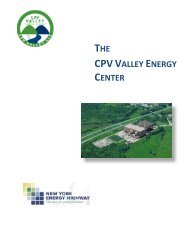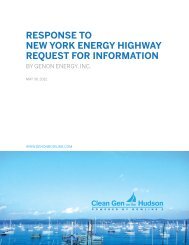Silicon Solution Joint Venture, LLC - Energy Highway
Silicon Solution Joint Venture, LLC - Energy Highway
Silicon Solution Joint Venture, LLC - Energy Highway
Create successful ePaper yourself
Turn your PDF publications into a flip-book with our unique Google optimized e-Paper software.
US SOLAR – WHITE PAPER 24 May 2012<br />
ability of many banks throughout the world to provide long-term debt finance. Beyond the<br />
banks' diminishing appetite for long-term lending, the US federal government's role as a direct<br />
renewable project investor is also decreasing due to the expiration last year of a key loan<br />
guarantee programme (though the federal government is poised to play a major role as a<br />
project host via military projects).<br />
• With many banks scaling back their long-term lending, others will gain market share. While<br />
borrowers with well-established lender relationships and solid project development track<br />
records may still be able to access long-tenor commercial loans, many borrowers will<br />
transition to 5-10 year 'semi-perms' (ie, shorter tenor loans, which are refinanced in the middle<br />
or end term). Banks will continue to be the dominant source of construction debt, as other<br />
institutions are not comfortable with the associated risks. Asian banks, which are better<br />
capitalised and therefore less affected by Basel III, will also do more term finance in the<br />
absence of active European lenders.<br />
• New investors will become comfortable with solar assets’ risks/rewards. While PV is a fairly<br />
mature technology within clean energy, compared with infrastructure projects such as natural<br />
gas pipelines or toll roads, it is new and therefore can be viewed as riskier. As the sector<br />
matures, increasing investor interest and decreasing perceived risk will lead to a lower cost of<br />
equity, debt and tax equity.<br />
Solar projects are good<br />
potential fit for<br />
insurance companies<br />
and pension funds,<br />
which seek stable and<br />
low-risk assets to match<br />
their long-term liabilities<br />
• Institutional investors in particular may become more active. Solar projects are a good<br />
potential fit for insurance companies and pension funds, which seek stable and low-risk assets<br />
to match the duration of their long-term liabilities. While these investors prefer not to take<br />
construction risk, they may become involved in refinancing construction debt, perhaps by<br />
'taking out' short-term lenders. They may also play significant roles on the equity side: some<br />
insurance companies have an inclination for buying operating solar assets under all-equity<br />
deals and then holding the assets for the remainder of the project lifetime: the reliable cash<br />
flows for projects with PPAs nicely match the funds' regular annual obligations.<br />
• High-liquidity vehicles will pave the way for the expanded role of new investors. While some<br />
large insurers (eg, MetLife, John Hancock) have experience investing directly in US solar<br />
projects, many institutional investors do not have project finance teams capable of doing the<br />
same, or simply prefer investments that are more liquid and more closely resemble other<br />
asset classes to which they are accustomed, such as bonds. Other examples of investors who<br />
have been on the sidelines to date but who could enthusiastically pursue public markets<br />
securities include hedge funds and mutual funds. (These high-liquidity vehicles are described<br />
in Sections 4.4-4.5.)<br />
• New non-financial corporates will enter the tax equity market. In March 2012, the White House<br />
hosted a session to educate new potential corporate investors on tax equity, and earlier this<br />
year, Chevron announced its intention to invest in solar projects in the 3-20MW range. Other<br />
companies may follow: the yields are attractive, the market is relatively uncompetitive, and<br />
some have experience with tax credits via the low-income housing sector. In the long-term,<br />
increased supply of tax equity may drive down yields from the current 7-9% range. But in the<br />
short-term, one tax equity investor mentioned that yields may trend upwards as the increased<br />
demand – due to the expiration of the cash grant – is met with inelastic supply. Additionally,<br />
large utilities with development arms such as Duke, NRG, enXco (affiliate of the European<br />
utility, EDF) and others – which typically internalised tax benefits – may not have much tax<br />
capacity remaining. Demand for tax equity will further increase as these companies go to the<br />
market for financing. However, as will be explained below, the list of new tax equity providers<br />
to meet that demand will be short.<br />
© Bloomberg New <strong>Energy</strong> Finance 2012<br />
Strictly no copying, forwarding, shared passwords or redistribution allowed without prior written permission<br />
of Bloomberg New <strong>Energy</strong> Finance. For more information on terms of use, please contact<br />
sales.bnef@bloomberg.net. Copyright and Disclaimer notice on page 28 applies throughout. Page 15 of 28



